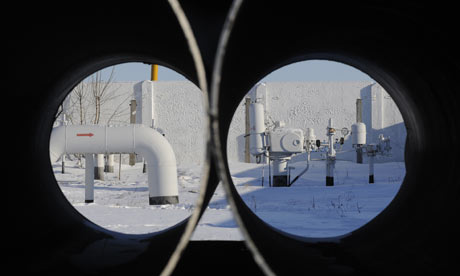
Implications of Ukraine’s Gas Imports from Europe
Publication: Eurasia Daily Monitor Volume: 10 Issue: 60
By:

According to Naftohaz Ukrainy officials, all the ongoing natural gas purchases from German RWE (see accompanying article) are carried out under a framework agreement signed in May 2012. This envisages deliveries of 5 billion cubic meters (bcm) in 2013, with the subsequent possibility of expansion to 10 bcm per year. Following up on that framework agreement, Ukrtranshaz signed bilateral technical agreements with the Polish and Hungarian pipeline operators, respectively (Interfax-Ukraine, March 28).
This development marks the start of a de-monopolization of Ukraine’s gas market, long captive to Gazprom. Growing volumes of gas reaching Western European spot markets tend to reduce prices through competition. A bi-directional use of pipelines, now mandatory in EU member countries, enables Ukraine to access gas supplies from RWE through Hungarian and Polish pipelines. The volumes seem likely to grow, and the potential exists for adding to the range of suppliers.
Ukraine intends to increase those imports if European gas prices continue to be lower than those charged by Russia to Ukraine. The Russian price (considerably above $400 per one thousand cubic meters) incorporates the $100 discount applying since 2010 for ten years ahead, in return for Ukraine’s consent to prolong the Russian Black Sea Fleet’s basing rights until mid-century. Without that discount Ukraine would have had to pay more than $500 per one thousand cubic meters of Russian gas. Yulia Tymoshenko negotiated and agreed that pricing formula as prime minister in 2009, and Viktor Yanukovych concluded the naval basing agreement as president in 2010.
Compared with Ukraine’s gas imports from Russia, the volumes imported from Europe look modest at present and in a short- to medium-term perspective. The net dynamic, however, looks promising for Ukraine as it rapidly cuts gas imports from Russia while gradually raising those from Europe.
According to the State Statistics Service, Ukraine imported 33 bcm of Russian gas in 2012, down by 27 percent from the 45 bcm it had imported in 2011. The price of Russian gas supplied to Ukraine in 2012 averaged $426 per 1,000 cubic meters, up by 4.5 percent from the 2011 price (Interfax-Ukraine, March 21). The import in 2012 is a far cry from the 52 bcm under contract, and also way below the 42 bcm subject to take-or-pay clauses (which Ukraine disregards). Ukraine proposes to cut gas imports from Russia even further in 2013, thanks to import diversification and decreased domestic consumption.
Ukrainian officials offer various scenarios for 2013, ranging from 27 bcm to less than 20 bcm of Russian gas imports. However, the picture becomes more complicated when taking into account the new role of Dmytro Firtash’s Ostchem as a significant gas importer and trader in its own right, separately from Naftohaz (see EDM, March 25). According to Firtash, he plans to import Russian gas in 2013, mostly for Ostchem’s own fertilizer production, but partly also for re-selling to other Ukrainian industrial consumers (Komersant-Ukraine, March 20). Thus, Ostchem’s imports from Russia may partly offset the decline of Naftohaz’s imports of Russian gas. While Gazprom begins losing its supply monopoly in Ukraine, Naftohaz begins losing its procurement monopoly.
Russia will in any case remain by far the largest gas supplier to Ukraine into the foreseeable future, albeit declining in both absolute and relative terms. Meanwhile, gas imports from Europe are starting to replace some of the Russian volumes that are no longer reaching Ukraine. Ukraine’s incipient diversification of gas supplies in itself is a more consequential fact than the price advantage at this stage. The inter-connection arrangements already made, and those in prospect, should result in a steady growth of supplies from Europe to Ukraine, aligning their price with European spot market prices. These twin processes of volume substitution and price alignment seem set to advance. They should translate into some degree of financial relief for Ukraine and counter-leverage in negotiations with Russia.
Ukraine is a party to the Energy Community and its Treaty (along with the European Union as a “party” and Ukraine’s direct neighbors in Central Europe as “participants”). The Energy Community aims to extend the EU internal energy market’s regulatory framework to the EU’s neighboring countries. This facilitates the coordinated reverse-use of their gas pipelines and their inter-connection for deliveries to Ukraine.
Russia is pressuring Ukraine to abandon the Energy Community, in return for Russian investments in the overdue modernization of Ukraine’s gas transit system, which still carries the lion’s share (albeit diminishing) of Russian gas exports to Europe. The proposed Russian “investments” would take the form of Gazprom sharing control over Ukraine’s transit system, not necessarily in co-ownership but under some other forms of de facto control. In that case, with Gazprom in a decision-making role, Ukraine would be pulled out of the Energy Community. It would also lose the opportunity to freely use its pipelines in the reverse mode for accessing gas supplies from Europe. The de-monopolization process would be rolled back in that case.
Ukrainian government officials, preeminently Energy Minister Eduard Stavytsky and Foreign Affairs Minister Leonid Kozhara, are ruling out the idea of abandoning the Energy Community (Interfax-Ukraine, March 27). Prime Minister Mykola Azarov’s statements, however, could be more convincing if he ruled out not only an outright “sale” of equity in Ukraine’s gas transit system to Gazprom, but also the more creative forms of handing over control de facto, which would re-instate the monopoly that Gazprom is now losing.




